Quick Summary:
Many programming languages, such as Ruby on Rails for Ruby and Django for Python, come with built-in frameworks for web development. On the other hand, PHP does not have a default setting and instead provides a variety of options. As a result, PHP frameworks are the most popular option for web development. Two of the best PHP frameworks, Laravel, and Symfony, will be compared. First, we’ll go deeper into each framework to see what they offer and then help you choose the best that meets your requirements.
Using a framework makes it much easier to handle things with less coding when developing an application. Coding standards are also available for PHP-based frameworks, which promote the best coding style, techniques, and approaches. Because a framework is the project’s stable foundation, you must select the framework that best meets your needs.
Let’s look at each of them individually before getting into the differences between Laravel and Symfony.
Laravel vs Symfony: Overview
To better understand both technologies, let’s take a quick overview of both Laravel and Symfony.
Laravel
Laravel is an open-source framework with a model-view-controller architecture. It creates a web application by combining existing components from several frameworks. The separation of ‘business logic code’ and ‘display code’ is possible with Laravel. It allows you to change the appearance simply, and Laravel is also faster at fixing bugs.
Third-party tools such as Memcached and Redis are also supported by Laravel, making quality web development easier and faster. It also assists in the remediation of the majority of significant online application security flaws such as SQL Injection, cross-site scripting, and cross-site request forgery. It uses PHPUnit to automate code testing, making it easy to test web applications.
Also Read – Speed Up your Laravel Website – Laravel Performance Optimization Tips
Symfony
Like Propel, Doctrine, PHPUnit, Twig, and Swift Mailer, Symfony is an open-source PHP project. It also uses MVC architecture, which aids in developing scalable web applications. The MVC approach also ensures that your project follows a logical structure. Symfony’s components are reusable and decoupled PHP libraries that serve as the foundation for web development projects. These components enable you to execute typical tasks without writing long lines of code.
Symfony includes one of the best capabilities for tracking behaviour called Symfony profiler, which allows developers to trace the behaviour of any application by mapping all of its operations and activities on the back-end site.
Laravel vs Symfony: Features
Both Laravel and Symfony have well-defined features that allow professional developers to write less code, resulting in fewer potential errors. First, let’s look at the differences between Lavarel and Symfony.
Laravel
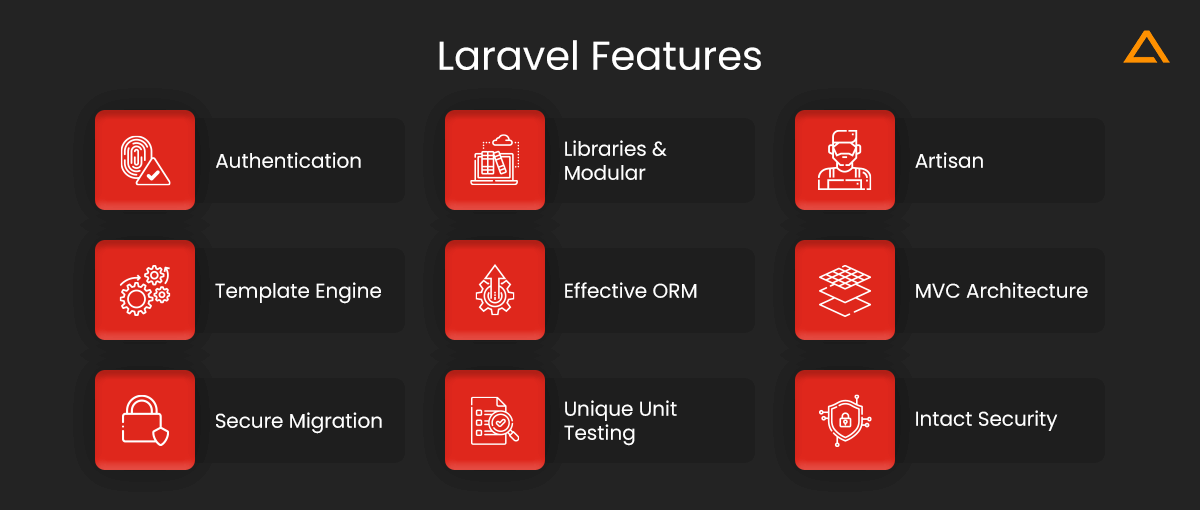
- Authentication
- Libraries & Modular
- Artisan
- Innovative Template Engine
- Effective ORM
- MVC architecture
- Secure Migration
- Unique Unit testing
- Intact Security
Also Read – Laravel Best Practices 2024 – Let’s Stealth Your Website with Ease
Symfony
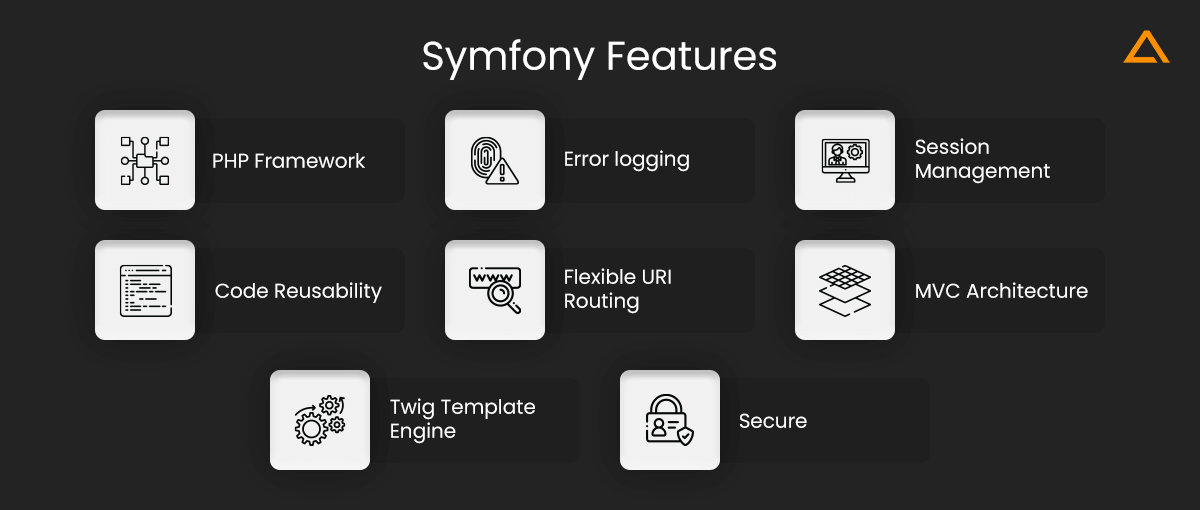
- High-performance PHP framework
- Error logging
- Session Management
- Code reusability
- Flexible URI Routing
- MVC architecture
- Twig template engine
- Secure
Laravel vs Symfony: Usage Statstics
The following section will find the market overview for both PHP frameworks.
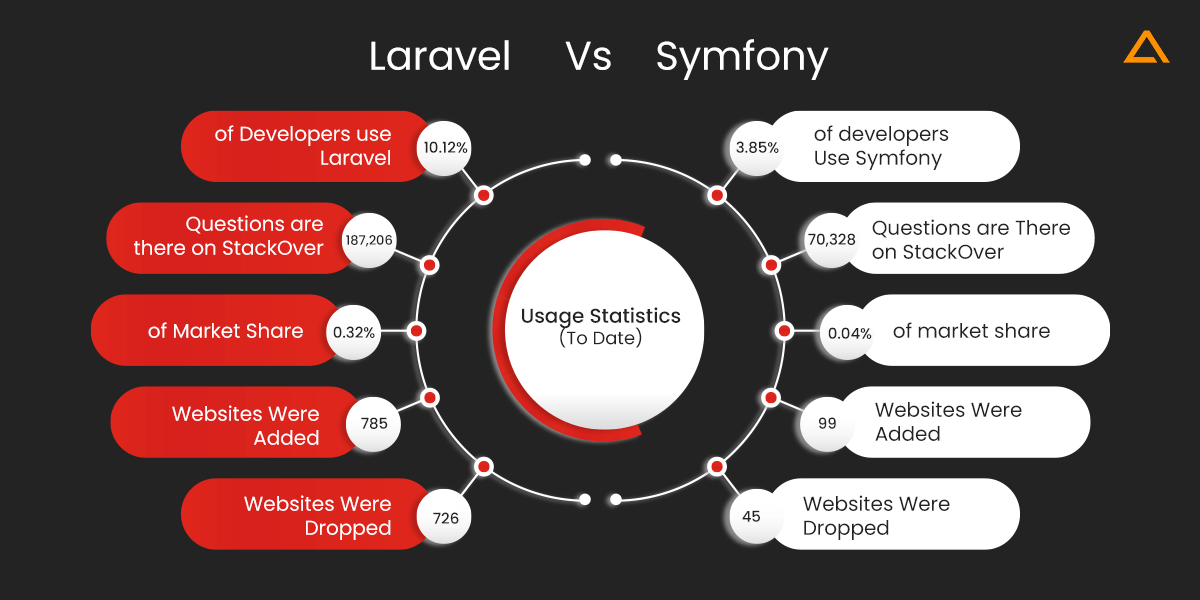
Laravel
- According to the StackOver Flow developers survey 2021, 10.12% of skilled developers use Laravel.
- There are 187,206 questions on stackover flow regarding Laravel.
- Laravel has a market share of 0.32%
- 785 websites were added, and 726 websites dropped Laravel last month.
Symfony
- According to the StackOver Flow developers survey 2021, 85% of developers use Symfony.
- There are 70,328 questions on stackover flow regarding Symfony
- Symfony has a market share of 0.04%.
- 99 websites were added, and 45 websites dropped using Symfony last month.
Php Laravel vs Symfony: Similarities
- Both are based on the PHP programming language.
- Supports multi-user & multi-language content
- Provide for scaffolding of the application & support text search
- Both frameworks support cross-platform
- Supports ORM (Object-relational mapping) Doctrine for Symfony and Eloquent for Laravel.
- Both provide database support
- Provides MVC support
“Are you looking to hire PHP Developers?”
Hire dedicated PHP developers from Aglowid to develop cost-effective cloud-based PHP web applications
Let’s take a look at a quick comparison between Symfony framework vs laravel
Quick Symfony Vs Laravel Comparison 2024
| Point | Symfony | Laravel |
| Official Website | https://symfony.com/ | https://laravel.com/ |
| Release Date | October 2005 | June 2011 |
| Recent Version | Version 6.1 | Version 8 |
| Gitstars | 26.4K | 26K |
| License | MIT License | MIT License |
| Stable Release | 6.0.2 | 8.81 |
| Repository | Symfony Repository | Laravel Repository |
| Flexibility | More Flexible | Less Flexible |
| Framework Type | Web Framework | Web Application Framework |
| Original Developers | Fabien Potencier | Taylor Otwell |
| Speed | Normal | Improved |
| Data Migration | Automatic | Manual |
| Data Modeling | Doesn’t require SQL Knowledge | Requires SQL Knowledge |
| Documentation | Basic Documentation on Symfony Community | Textual & Video Tutorial on Laracasts, Treehouse, Sitepoint, Codebright, and Github |
Laravel vs Symfony: Key Differences
Both PHP frameworks are popular in the market; Let’s discuss some of the major differences that we have divided into technical and marketing differences.
Technical Differences
Following are some of the technical Symfony vs laravel differences. Let’s understand them in detail.

Laravel Vs Symfony: Performance
By default, Laravel has a set of unified APIs for caching views, Symfony cache views, and source code. As a result, Symfony’s website takes longer to load. Laravel’s average loading time is 60 milliseconds, while Symfony’s is 250 milliseconds. Symfony components are used in the Laravel PHP framework. Laravel also enables you to program in PHP with less coding and better performance. If you want to build a web application for business, Laravel is the framework to choose because it provides faster delivery with fewer resources.
In the early stages of the project, Symfony requires more time, development effort, and financial resources. In addition, Symfony is difficult to set up. Despite this, Symfony is an excellent choice for complicated web projects because its bespoke functionality fits your needs well. Symfony development services are ideal if you have a complicated web application.
Symfony Vs Laravel: Scaling & Modularity
Symfony is based on a packaged modular structure that includes many reusable components. When creating a web application, ensure that it is more modular. Framework Bundle, for example, is a Symfony bundle that allows multiple apps to share code and functionalities. It makes use of reusable parts to ensure that it is modular.
The architecture of Laravel differs from that of other PHP frameworks. It’s a little more restricted when you need to make quick modifications to your online applications. As a result, any modifications to the application modules at the initial level necessitate changing the entire code unit. It employs an MVC-based design with several pre-installed dependencies.
Symfony Vs Laravel: Templating Engine
The blade is a simple but powerful templating engine used by Laravel. Unlike any other PHP templating system, Blade allows skilled PHP Developers to use plain PHP code. All Blade views are compiled into plain PHP code and cached until they are changed. As a result, the blade tempting engine adds almost no overhead to your application.
Twig, created by Fabien Potencier, is used by Symfony. TWIG allows you to create more web designer-friendly and powerful templates than PHP ones since they are concise and readable. Moreover, Twig can be utilized in Laravel thanks to the TwigBridge project, which allows you to use Twig in Laravel without any problems.
In the end, there are two essential issues to consider.
1) In Blade, you may use ordinary PHP code. Some developers appreciate how simple it is, while others believe it encourages them to combine business and presentation logic.
2) On the other hand, Twig addresses all of the concerns and addresses the issue of portability, which is its primary benefit.
Symfony Framework Vs Laravel: Database Support
Because it stores, organizes, and maintains information in a single software program, the organization’s database support system is critical. Using a database support system in web project development boosts productivity and lowers costs. Both symform and Laravel employ ORM to handle data (Object Related Mapping). Eloquent is used by Larvel, while Symform uses doctrine.
Database migrations in Symfony are fully automated. However, in the given code, developers must create certain fields. Laravel, on the other hand, makes use of database migrations and eliminates the requirement to declare fields. These two PHP frameworks make handling and manipulating data easier while using an ORM-supported database.
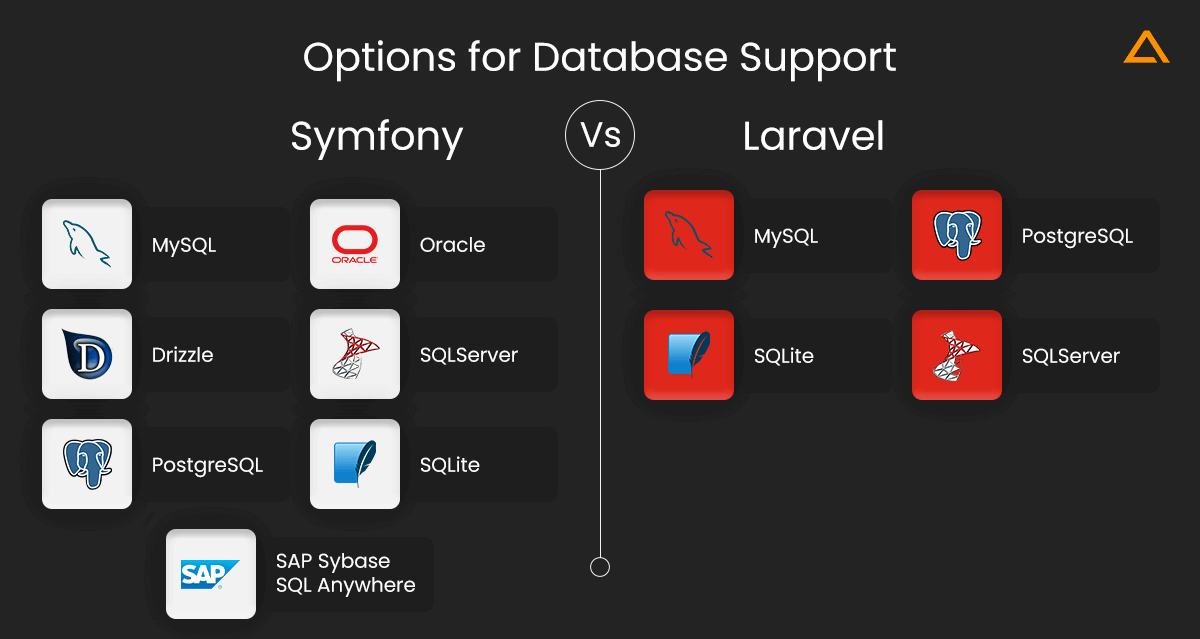
Symfony provides a few more options for database support, for example:
- MySQL
- Oracle
- Drizzle
- SQLServer
- PostgreSQL
- SQLite
- SAP Sybase SQL Anywhere
While Laravel supports only a few of them
- MySQL
- PostgreSQL
- SQLite
- SQLServer
Framework Laravel Vs Symfony: Scaffolding
Scaffolding is a tool that builds CRUD from your database for you automatically. Use the templates as a foundation on which to build your application. Unfortunately, there is no scaffolding tool integrated into the Laravel PHP framework. Several tools, however, can be combined with Laravel.
SensioGeneratorBundle, on the other hand, comes with Symfony and provides instructions for scaffolding bundles, controllers, forms, and CRUD-based backends. You may also use the generator-Symfony package -sf to scaffold Symfony PHP apps like Browsersync, Browserify, different CSS Preprocessors, and service workers using Yeoman.
Laravel Vs Symfony: Routing
In each framework, the application’s list of routers and binding to controllers can be customized in its method. So, in Laravel, the following Route::get('/test', 'TestController@test')->name('test name') should be supplied in the routing file routes/api.php to signal that the route “/test” should be processed by the test method of the TestController controller;
The same can be done with Symfony by routing YAML files or annotations. Each framework provides the ability to organize routes and assign prefixes to them assign HTTP methods. These routes will be accessible and handy support for working with GET and POST parameters.
Laravel Vs Symfony: Learning Curve
Laravel has a relatively easy learning curve. Developers can learn about this framework in various methods, including through documentation, video assistance, and tutorials.
Learning Symfony is more challenging than learning Laravel. While there is documentation, there isn’t as much community support or tutorials as with Laravel.
Symfony vs Laravel: Dependency Injection
There are numerous services and components in applications, each with its interdependencies. Therefore, it’s critical to keep track of all the information about the objects you’ve generated and their dependencies. Service Container is a PHP component that builds specified services and keeps the information about produced objects and dependencies. It’s a fantastic component that aids in implementing SOLID design principles in your application.
You don’t need to create any dependency configurations with Laravel. Laravel examines dependencies automatically. The auto-detection in Laravel is fantastic. Symfony has a feature called “autowire” that provides comparable functionality. It’s disabled by default, but you may enable it by adding autowire: true to your dependent setup. Laravel is significantly simpler than Symfony, which requires some setting.
Symfony vs Laravel: Security
The security system in Symfony is powerful, but it’s also difficult to set up. It supports a variety of authentication methods and a very fine-grained permission mechanism. While Laravel has a more straightforward approach to security, basic features are sufficient in most circumstances.
Laravel vs Symfony: Speed
The performance benchmark for Laravel is easily expandable. Laravel enables rapid development with minimal coding effort. Laravel is adaptable since it makes use of Symfony components. Compared to Laravel, Symfony is slower when it comes to complex web projects. It promotes adaptability as well as peak performance. It’s simple to extend, and PHP Symfony comes with various alternatives.
“Are you looking to hire LARAVEL Developers?”
Find the best full-stack Laravel Developers in India to start your web development project within 48 hours
Symfony vs Laravel: Benchmark
Let’s take a look at the benchmarks of Symfony and Laravel.
Php Symfony vs Laravel: Popularity
According to SimilarTech, Laravel is used by 135,974 websites, while 11,654 websites utilize Symfony.
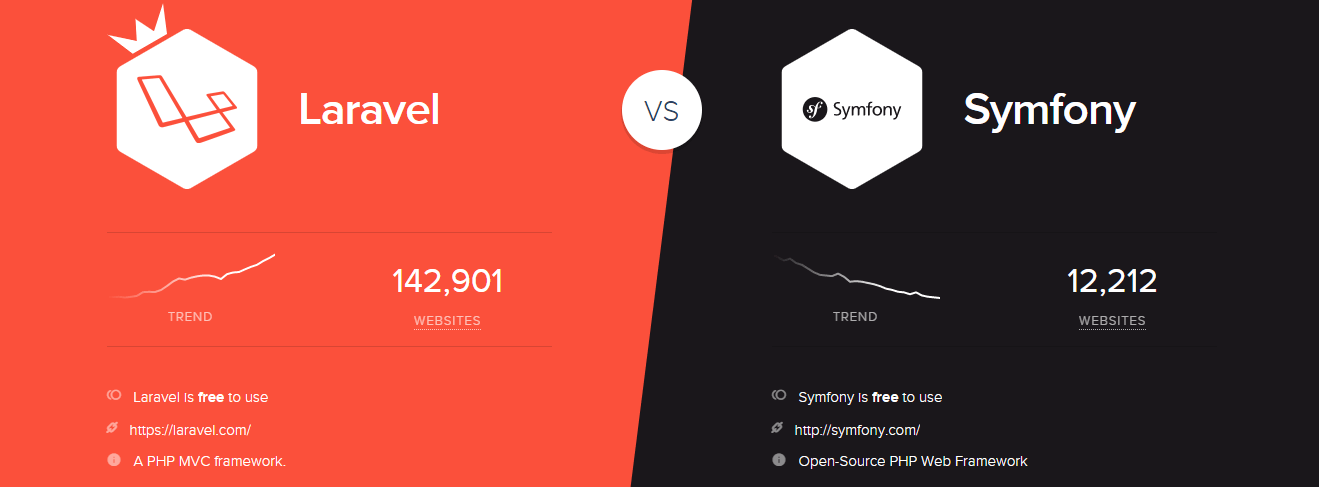
Laravel vs Symfony: Market Share
When the market share of these frameworks is compared, PHP Laravel comes out on top in 10K, 100K, and 1M sites. The comparison graph is shown below.
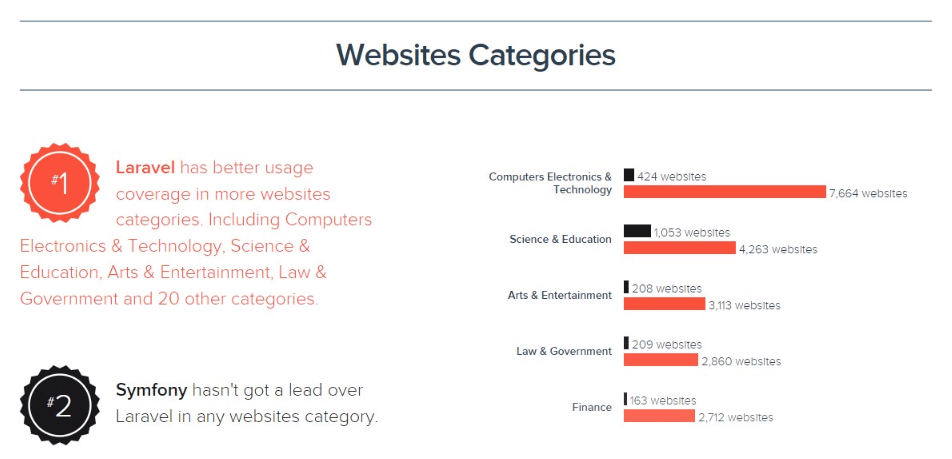
Laravel vs Symfony: Website Category
Even though Symfony is the most popular PHP framework, its websites still lag behind Laravel. The majority of Symfony-powered websites are in the science and education fields. The graph below depicts the framework’s application in various industries.
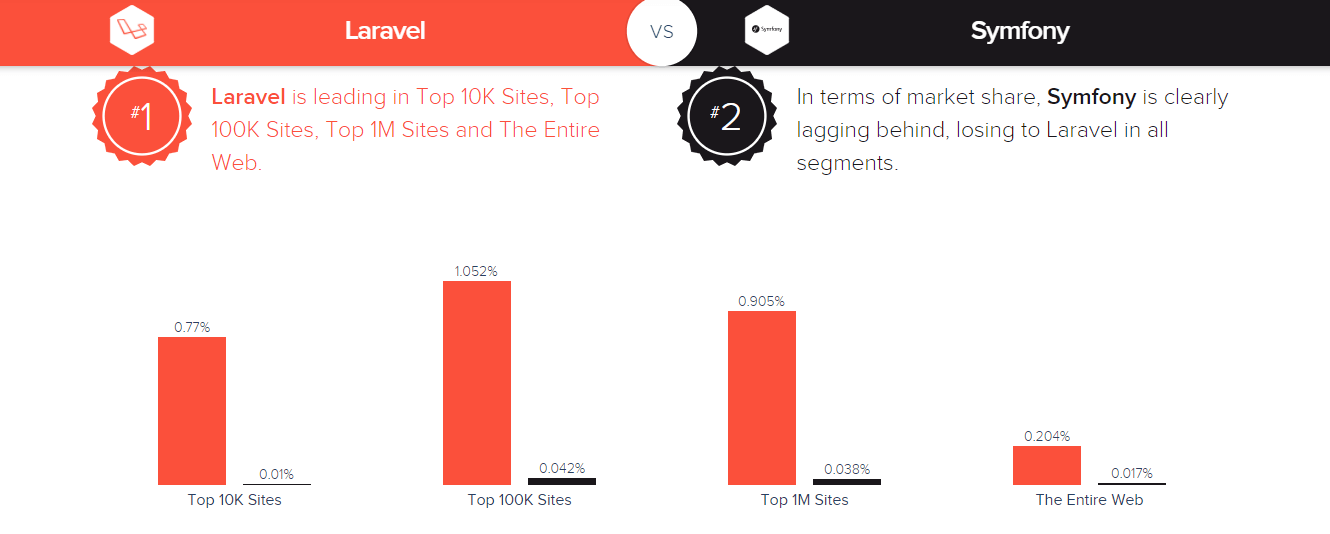
Symfony vs Laravel: Jobs
- According to LinkedIn, there are 16373 jobs available for Laravel
- Whereas there are 8496 jobs available for Symfony.
Laravel vs Symfony: Salary
- According to Indeed, PHP Laravel developer earns $92,374/yr.
- Symfony developers earns $92,374.
Laravel vs Symfony: Pros & Cons
Following are the pros and cons of Laravel and Symfony.
Laravel
| Pros | Cons |
| Pre-built tools | Unreliable third-party |
| Lightweight | Backend Congestion |
| Allows API integration | Not compatible updates |
| Automated testing | Unreliable third-party libraries |
Symfony
| Pros | Cons |
| Biggest Community | Steep learning Curve |
| Well-Known Platforms use Symfony | Relies on other technology |
| Up-to-date | Slower Performance |
Laravel vs Symfony: When to Use
Following are the scenarios where you use laravel and Symfony.
Laravel

- If you want to develop interactive website layouts.
- Using Blade Template Engine, create an advanced application without additional costs and overhead components.
- Create a customized app using various widgets with JS & CSS.
- Scalable server-side framework with best documentation and community support
- Develop a web application quicker with an Object-oriented library.
Symfony

- Develop large-scale industry-standard applications.
- Develop applications with real-time data synchronization
- You want to use the search engine feature.
- Create a customizable marketplace.
- Need collaborative suite for enterprise applications.
Laravel vs Symfony: Use Cases
The following are the use cases for Laravel and Symfony.
Laravel

- SaaS-based web applications
- On-demand streaming web apps.
- E-learning apps
- Stock trading based web management systems
- Multi-Lingual CMS systems
- Self-hosted website performance monitoring apps
- Apps with reward & recognization
Symfony

- Single-page Applications
- Bulletin board Software
- CMS
- Intranet Software & tools
- Enterprise Grade Applications
Laravel vs Symfony: Popular apps built
Following is the list of popular applications using the Laravel and Symfony framework.
Laravel

- RazorPay
- MasterCard
- Wattpad
- Deloitte
- Flutterwave
- Tesco
Symfony

- Accenture
- Trivago
- Practo
- Statista
- Colvin
- Naukri.com
have a unique app Idea?
Hire Certified Developers To Build Robust Feature, Rich App And Websites
Laravel vs Symfony: Which one to Choose?
Both Laravel and Symfony are robust, reliable, and feature-rich frameworks. There is, however, no obvious answer as to which one should be chosen. It all comes down to your requirements. If you’re a new product or working on smaller tasks, Laravel is the best option for you. Furthermore, some programmers are professionals in PHP Laravel; as a result, scaling the project with more Laravel engineers is easier. However, if you have a long-term complex project, PHP Symfony may be a superior option because it is fast, extendable, stable, adaptable, and long-lasting.
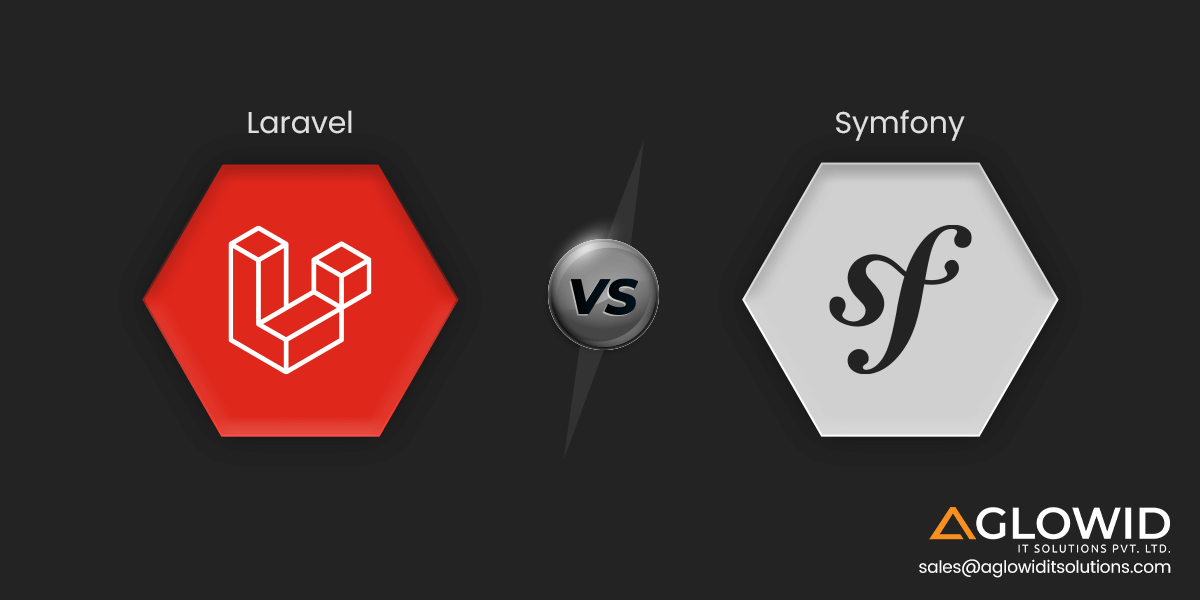




 Say
Say